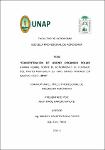Concentración de abono orgánico foliar (Humus líquido), sobre el rendimiento de forraje del pasto Pennisetum sp. King grass morado en Iquitos, Perú - 2015
Abstract
This research was carried out at the National University of the Peruvian Amazon in the Faculty of Agronomy in the Vaccine Project in the
Zungarococha Fundo, entitled “Concentration of Foliar Organic Fertilizer (Liquid Humus), on the forage yield of Pennisetum sp. Purple King grass in
Iquitos, Peru - 2015 ”. The evaluations were carried out at the ninth week after sowing with vegetative seed (bushes), in plots of 8 m x 2 m (16 m2) and an
experimental area of 1056 m2. With a Random Complete Block Design (DBCA) design, with five treatments and four repetitions, the treatments under study
were: T0 (No application), T1 (15% liquid Humus), T2 (30% Liquid Humus), T3 (Humus liquid 45%) and T4 (Humus liquid 60%), the statistical package of
SPSS 21 was applied to the field data, giving the following results: It is observed that the best yields were given in the treatment T4 (60% of Liquid
humus and 40% water), at plant height with 148.90 cm, coverage with 96.53%, green matter with 4.15 kg / m2 and dry matter with 1.13 kg / m2, and maximum
yield of green matter per hectare is 41,475 kilos and the lowest yield of green matter was 19,475 kilos at the 9th week of cutting, it occurred with the
concentration of 60% and 15% of liquid humus. La presente investigación se realizó en la Universidad Nacional de la
Amazonía Peruana en la Facultad de Agronomía en el Proyecto Vacunos en
el Fundo de Zungarococha, titulado “Concentración de Abono Orgánico Foliar
(Humus líquido), sobre el rendimiento de forraje del pasto Pennisetum sp.
King grass morado en Iquitos, Perú - 2015”. Las evaluaciones fueron
realizadas a la novena semana después de la siembra con semilla vegetativa
(matas), en parcelas de 8 m x 2 m (16 m2) y un área experimental de 1056 m2.
Con un diseño de Diseño de Bloque Completo al Azar (D.B.C.A), con cinco tratamientos y cuatro repeticiones, los tratamientos en estudio fueron: T0 (Sin
aplicación), T1 (Humus líquido 15%), T2 (Humus líquido 30%), T3 (Humus líquido 45%) y T4 (Humus líquido 60%), se aplicó el paquete estadístico de
SPSS 21 a los datos de campo, dando los siguientes resultados: Se observa que los mejores rendimientos se dieron en el tratamiento T4 (60 % de Humus
líquido y 40% de agua), en altura de planta con 148.90 cm, cobertura con 96.53 %, materia verde con 4.15 kg/m2 y materia seca con 1.13 kg/m2, y
rendimiento máximo de materia verde por hectárea es de 41,475 kilos y el menor rendimiento de materia verde fue de 19,475 kilos a la 9na semana de
corte, se dio con la concentración del 60% y 15% de humus líquido.
Collections
- Tesis [671]


